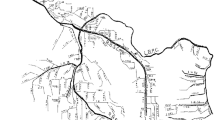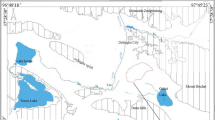Abstract
There is a need for improvement in the operation and management of many irrigation and drainage systems worldwide. Computer models are used widely for better management. One of such models is HEC-RAS that was applied to Ordibehesht Canal at the Doroodzan irrigation network, northwest of Fars province in the southern Iran. The model was calibrated and validated for two irrigation seasons during 2001 and 2002. The present gate opening rules used to control the offtakes were simulated by the model and the discharge reductions were evaluated. Discharge reduction of offtakes due to discharge reductions at system source were evaluated by the model. Results show that the present rule is not appropriate for the present system. Fluctuations of discharge at the beginning of canal show considerable and nonuniform changes in discharge of offtakes along the Ordibehesht Canal. The head offtakes show more reductions in the water delivered than middle and tail offtakes. A new sensitivity indicator was defined and used to show the response of offtakes due to discharge changes at system source. The study also shows that HEC-RAS model can be used successfully for a large and complex irrigation system for evaluation of its performance in the absence of observed flow data and improvement of irrigation management plans.
Similar content being viewed by others
References
Bos M.G. 1997. Performance indicators for irrigation and drainage. Irrigation and Drainage Systems 11: 119–137.
Bos M.G. 1988. Discharge Measurement Structures. ILRI Publishers, Vol. 20, 3rd edn.
Clemmens A.J., Holly F.M. & Schuurmans W. 1993. Description and evaluation of program: DUFLOW (ASCE). Journal of Irrigation and Drainage Engineering 119: 724–734.
Holly F.M. & Parish J.B. 1993. Description and evaluation of program CARIMA (ASCE). Journal of Irrigation and Drainage Engineering 119: 703–713.
Jabro J.D., Toth J.D. & Fox R.H. 1998. Evaluation and comparison of five simulation models for estimating water drainage fluxes under corn. Journal of Environmental Quality 27: 1376–1381.
Javan M., Sanaee-Jahromi S. & Fiuzat A.A. 2002. Quantifying management of irrigation and drainage systems (ASCE). Journal of Irrigation and Drainage Engineering 128: 19–25.
Kumar P., Mishra A., Raghuwanshi N.S. & Singh R. 2002. Application of unsteady flow hydraulic-model to a large and complex irrigation system (Elsevier). Agricultural Water Management 54: 49–66.
Merkley G.P. & Rogers D.C. 1993. Description and evaluation of program CANCAL (ASCE). Journal of Irrigation and Drainage Engineering 119: 714–723.
Mishra A., Anund A., Singh R. & Raghuwanshi N.S. 2001. Hydraulic modeling of Kangsabati Main Canal for performance assessment (ASCE). Journal of Irrigation and Drainage Engineering 127: 27–34.
Molden D.J. & Gates J.K. 1990. Performance measures for evaluation of irrigation water delivery systems (ASCE). Journal of Irrigation and Drainage Engineering 116: 804–823.
Renault D. 2000. Operational sensitivity of irrigation structures (ASCE). Journal of Irrigation and Drainage Engineering 126: 157–162.
Renault D. & Hemakumara H.M. 1999. Irrigation offtake sensitivity (ASCE). Journal of Irrigation and Drainage Engineering 125: 131–136.
Rogers D.C. & Merkley G.P. 1993. Description and evaluation of program USM (ASCE). Journal of Irrigation and Drainage Engineering 119: 693–702.
Sanaee-Johromi S., Feyen J., Wyseure G. & Javan M. 2001. Approach to the evaluation of undependable delivery of water in irrigation schemes. Irrigation and Drainage Systems 15: 197–213.
Sanaee-Jahromi S., Depeweg H. & Feyen J. 2000. Water delivery performance in the Doroodzan irrigation scheme, Iran. Irrigation and Drainage Systems 14: 207–222.
Schuurmans W. 1993. Description and evaluation of program MODIS (ASCE). Journal of Irrigation and Drainage Engineering 119: 735–742.
Singh R., Refsgaard J.C., Yde L., Jorgensen G.H. & Thorsen M. 1997. Hydraulic-hydrological simulations of canal-command for irrigation water management. Irrigation and Drainage Systems1 1: 185–213.
U.S. Army Corps of Engineers 2001. HEC-RAS: User’s and Hydraulic Reference Manual.
Van Waijjen E.G., Hart W.W.H., Kuper M. & Brouwer R. 1997. Using a hydro-dynamic flow model to plan maintenance activities and improve irrigation water distribution: application to the Fordwah distributary in Punjab, Pakistan. Irrigation and Drainage Systems 11: 367–386.
Author information
Authors and Affiliations
Corresponding author
Rights and permissions
About this article
Cite this article
Shahrokhnia, M.A., Javan, M. Performance assessment of Doroodzan irrigation network by steady state hydraulic modeling. Irrig Drainage Syst 19, 189–206 (2005). https://doi.org/10.1007/s10795-005-5425-4
Issue Date:
DOI: https://doi.org/10.1007/s10795-005-5425-4




